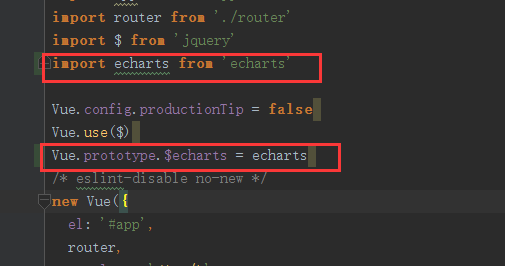1.安装echarts
首先安装vue-cli脚手架工具,我之前博客有写安装方法,此处省略。然后安装echarts:
1)在命令行输入 npm install echarts -S
2)在main.js中引入,代码如下:

红色框住的就是引入的代码。
2.使用方法
1)新建一个second.vue页面写入以下代码:
<template>
<div class="">
<h1>{{ msg }}</h1>
<div class="pic-nature">
<div id="myChart" :style="{width: '300px', height: '300px'}"></div>
</div>
</div>
</template>
<script>
export default {
name: 'second',
data () {
return {
msg: 'myChart'
}
},
mounted () {
this.drawBar()
},
methods: {
drawBar () {
let myChart = this.$echarts.init(document.getElementById('myChart'))
// 绘制图表
myChart.setOption({
title: { text: '柱状图' },
tooltip: {},
xAxis: {
data: ['笔记本', '钢笔', '圆珠笔', '橡皮擦', '文具盒']
},
yAxis: {},
series: [{
name: '数量',
type: 'bar',
data: [5, 10, 11, 23, 22]
}]
})
}
}
}
</script>
<style scoped>
.pic-nature {
text-align: center;
display: inline-block;
}
</style>
在主页面写入如下代码:

表示一个按钮,点击该按钮就可以跳入新建的界面。
新建一个路由,在  中写入如下路由代码:
中写入如下路由代码:
2)如果不想新建一个页面来使用echarts,自己只是想试试echarts的话可以在app.vue中写入刚刚‘1)’的代码,然后运行即可。
3.运行结果如下:




